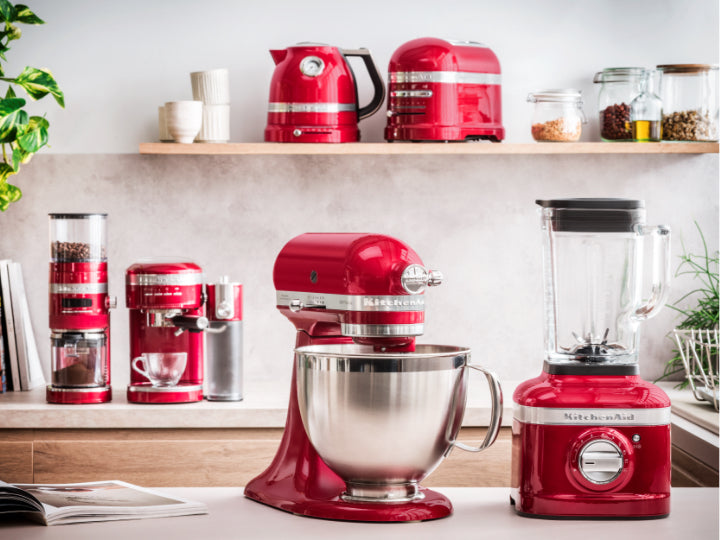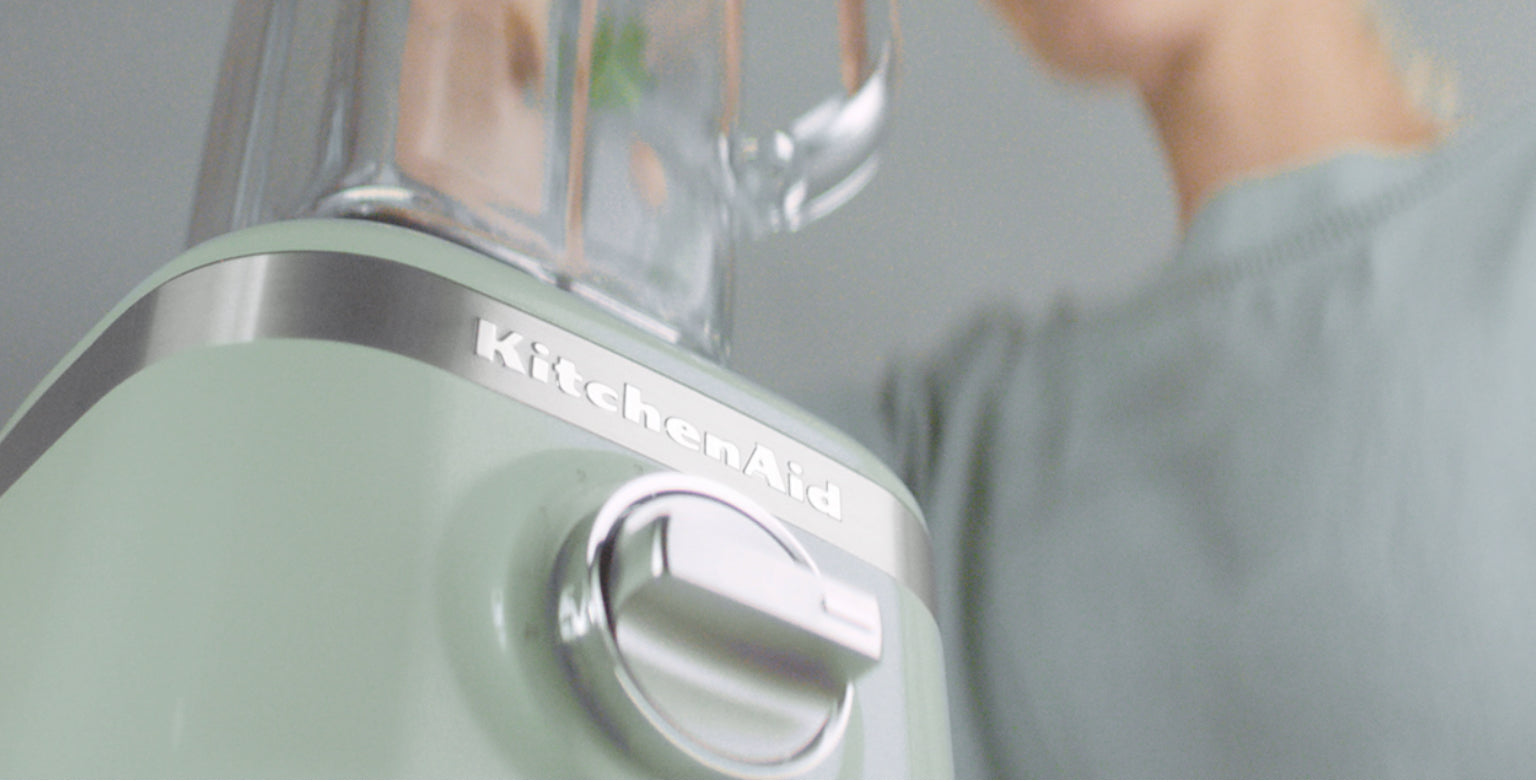
Feeling unsure or have a problem? Let's get you the help you need. Please contact our team below. We'll reply as quickly as we can.
Select Payflex at checkout across thousands of online
stores.
Get it now, but spread your payments either over 6 weeks OR
3 over 3 paydays.
Every purchase you make with Payflex is interest-free and
you get your goods right away.
PayJustNow offers you 3 equal interest-free instalments and gives you a rad new way to pay - today!
When you first unpack your KitchenAid tilt-head mixer, it's time to set it up. Find out how to assemble and adjust it ready to create. See the steps...
Your stand mixer is designed to be straightforward to use, so you will quickly become familiar with it and enjoy getting creative. Here are the instructions for setting it up.
How to secure the bowl:
1. Turn OFF (speed '0')
2. Unplug the mixer or disconnect power.
3. Tilt the motor head back.
4. Place bowl on silver metal bowl clamping plate.
5. Turn the bowl gently in a clockwise direction, making sure handle or spout of glass bowls does not touch the back of the mixer base.
How to remove the bowl:
1. Turn OFF (speed '0')
2. Unplug the mixer or disconnect power.
3. Tilt motor head back.
4. Turn bowl counterclockwise
How to attach the accessories (dough hook, paddle or wire whisk):
1. Turn OFF (speed '0')
2. Unplug the mixer or disconnect power.
3. Tilt the motor head back.
4. Slip accessory onto beater shaft and press upward as far as possible.
5. Turn accessory to the right, hooking beater over the pin on the shaft.
How to remove the accessories (dough hook, paddle or wire whisk):
1. Turn OFF (speed '0')
2. Unplug the mixer or disconnect power.
3. Tilt motor head back.Press beater upward as far as possible and turn left.
4. Pull beater from beater shaft.
How to check the bowl clearance (height):
Your mixer is adjusted at the factory for optimum mixing, with the paddle (flat beater) just clearing the bottom of the bowl. If, for any reason, this hits the bottom of the bowl or is too far away from the bowl, you can correct it quickly.
1. Turn OFF (speed '0')
2. Unplug the mixer or disconnect power.
3. Tilt motor head back.
4. Turn the screw SLIGHTLY counterclockwise (left) to raise the paddle or clockwise (right) to lower the paddle.
5. Adjust so that the paddle just clears the surface of the bowl. If you over adjust the screw, you may not be able to lock the motor head when it is lowered.
NOTE: When correctly adjusted, the paddle will not strike the bottom or side of the bowl. If the paddle is too low and it strikes the bowl, the coating may wear off the beater, or the wires on the whisk may wear.
Signs that your mixer needs to be adjusted:
- Ingredients on the bottom of the bowl are not being incorporated means the beater is too high.
- Head not locking into place means the beater is too high.
- The white paddle is chipping on the bottom means the beater is too low.
Discover how to get creative with optional attachments on your KitchenAid mixer, using the multipurpose attachment hub. See our advice and steps...
You can take advantage of an exciting range of mixer attachments to explore new culinary possibilities with your KitchenAid mixer.
This is how:
Make sure the attachment is compatible with your mixer:
KitchenAid mixers have a universal attachment hub, which is a power hub that the attachments plug into. All attachments that go into the power hub will fit all mixers, regardless of age.
Only exceptions:
Our Mixer bowl-lift 6.9L - Professional (5KSM7990X), which is not compatible with all of the attachments. The ice cream maker will not fit on the Mixer tilt-head 3.3L (KSM3311), due to the bowl being too large for the mini base. The compatibility of each accessory will be printed on the box.
How to put the attachment in the mixer's attachment hub:
1. Turn the mixer off (speed '0') and unplug.
2. Remove the attachment hub cover, either by flipping up the cover for mixers with a flip-up cover or by unscrewing on mixers with a removable cover.Insert the attachment shaft housing into the attachment hub.
3. Tighten the mixer attachment hub knob until the attachment is completely secured to the mixer.
Discover how to clean the pasta roller and cutters for your KitchenAid mixer. It's important to clean them after use. Here are the steps...
Once you've enjoyed making homemade pasta with the pasta roller and cutters (5KSMPRA) or pasta roller on its own (5KSMPSA), you need to make sure they're nice and clean before you store them away.
How to clean the pasta cutter:
NOTE: Do not use metal objects to clean out the pasta cutter. Do not wash the the body in the dishwasher or immerse in water or other liquids. Only the blades are dishwasher-safe.
1. Turn mixer off (speed '0') and unplug.
2. Completely disassemble the pasta cutter.
3. After cutting pasta, let the pasta cutter air dry for one hour, then remove any dried dough using the cleaning brush. If the dried dough is difficult to remove, try tapping the attachment with your hand. Use a toothpick if necessary.
4. After cleaning out all remaining dried dough, polish the pasta cutter with a soft, dry cloth and store in a dry place at room temperature. Do not wash the body of the pasta cutter in the dishwasher.
NOTE: Never use a knife or any other sharp object to remove excess dough. Do not run a dish towel or any other cloth through the rollers to clean them.
How to clean the pasta roller:
NOTE: Do not use metal objects to clean out the pasta roller. Do not wash the pasta roller in the dishwasher or immerse in water or other liquids. The pasta roller should be hand washed.
1. Turn mixer off (speed '0') and unplug.
2. Completely disassemble pasta roller.After cutting pasta, let the pasta roller air dry for one hour, then remove any dried dough using the cleaning brush. If the dried dough is difficult to remove, try tapping the attachment with your hand. Use a toothpick if necessary.
3. After cleaning out all remaining dried dough, polish the pasta roller with a soft, dry cloth and store in a dry place at room temperature. Do not wash the pasta roller in the dishwasher.
NOTE: Never use a knife or any other sharp object to remove excess dough. Do not run a dish towel or any other cloth through the rollers to clean them.
If the dough hook, wire whisk, or paddle (flat beater) is stuck on your KitchenAid mixer, don't worry. Here are some tips to remove the mixer accessory...
Here's what to do if an accessory (dough hook, whisk, or paddle - also called a flat beater) is stuck on the beater shaft of your mixer.
Is there food stuck in the opening?
Food particles can build up inside the beater cavity and stick to the beater shaft, making it difficult to either remove the beater or to put it on the beater shaft. If washing the beater in the dishwasher, make sure to insert it point down so that food particles cannot go into the opening.
Beaters should not be stored on your mixer when not in use because ingredients can get into the beater cavity and harden, which can also make them difficult to remove.
However, if a beater is stuck, there are some things you can do.
Tips for removing a stuck beater
There are a couple of tricks that can help remove a stuck beater.
Use a warm compress:
1. Compress a wet, warm towel around the beater shaft for 10 minutes.
2. Re-warm it after the 10 minutes, put it on again, and let it sit for another 1-2 minutes. This will re-warm the aluminum, causing it to expand. After this time, try to wiggle and remove the beater.
Mineral oil
If the beater does not come off with the warm compress, try applying a small amount of mineral oil to the beater shaft, above the beater and in the slot where the beater attaches to the beater shaft pin. Allow the oil to sit on the beater shaft for several minutes, and then remove the beater. If you don't have any mineral oil, you can use a vegetable oil cooking spray instead. If you use vegetable oil, make sure to clean the beater shaft very thoroughly after the beater is removed because it can become very sticky over time.
Once you've removed the beater
Once the beater is off, soak the beater in hot, soapy water and clean out the beater cavity thoroughly. Use a wooden skewer to remove any build-up of food particles or oxidation residue. You may also want to apply a little mineral oil to the beater cavity before putting it back on the beater shaft.
Frustrated by dough climing up the dough hook in your mixer? If you are experiencing this baking problem, then take a look at our troubleshooting tips...
When you're kneading bread dough, you may sometimes find that the dough seems to 'climb up' the hook accessory. If you are encountering this problem, here are some ideas:
Are you kneading for too long?
Kneading bread in a KitchenAid mixer for just 2 minutes is equivalent to kneading by hand for 10-12 minutes — thanks to the highly effective planetary action of the mixer. This means that you may need to reduce your favourite recipe's mixing and kneading times.
When the dough climbs up the hook, this is typically an indication that the kneading process is complete. A sticky dough will tend to climb the dough hook, and may even climb over the collar of the dough hook. Note that dough that contains eggs tends to be stickier and so climb the hook more easily. Most specialty grains, especially rye flour, form a sticky dough and will climb the hook more than white flour dough.
Are you using the right speed?
Speed 2 is the only speed that should be used for kneading.
Extra tips for kneading dough:
Adding a little more flour (1 tablespoon at a time) will help the dough not to climb the hook as much.
It's important to realise, however, that some dough will have a stickier consistency, so don't try to overcompensate with additional flour because it will make the bread too dry.

Call us: +27 21 555 0700 (Mon-Fri: 08:30 - 17:00)
WhatsApp: +27 82 621 8384 (Mon-Fri: 08:30 - 17:00)
Email us: hello@kitchenaidafrica.com
Visit us: 50 Milner Street, Metro Industrial, Cape Town 7405

50 Milner Street, Metro Industrial Township, Cape Town 7405